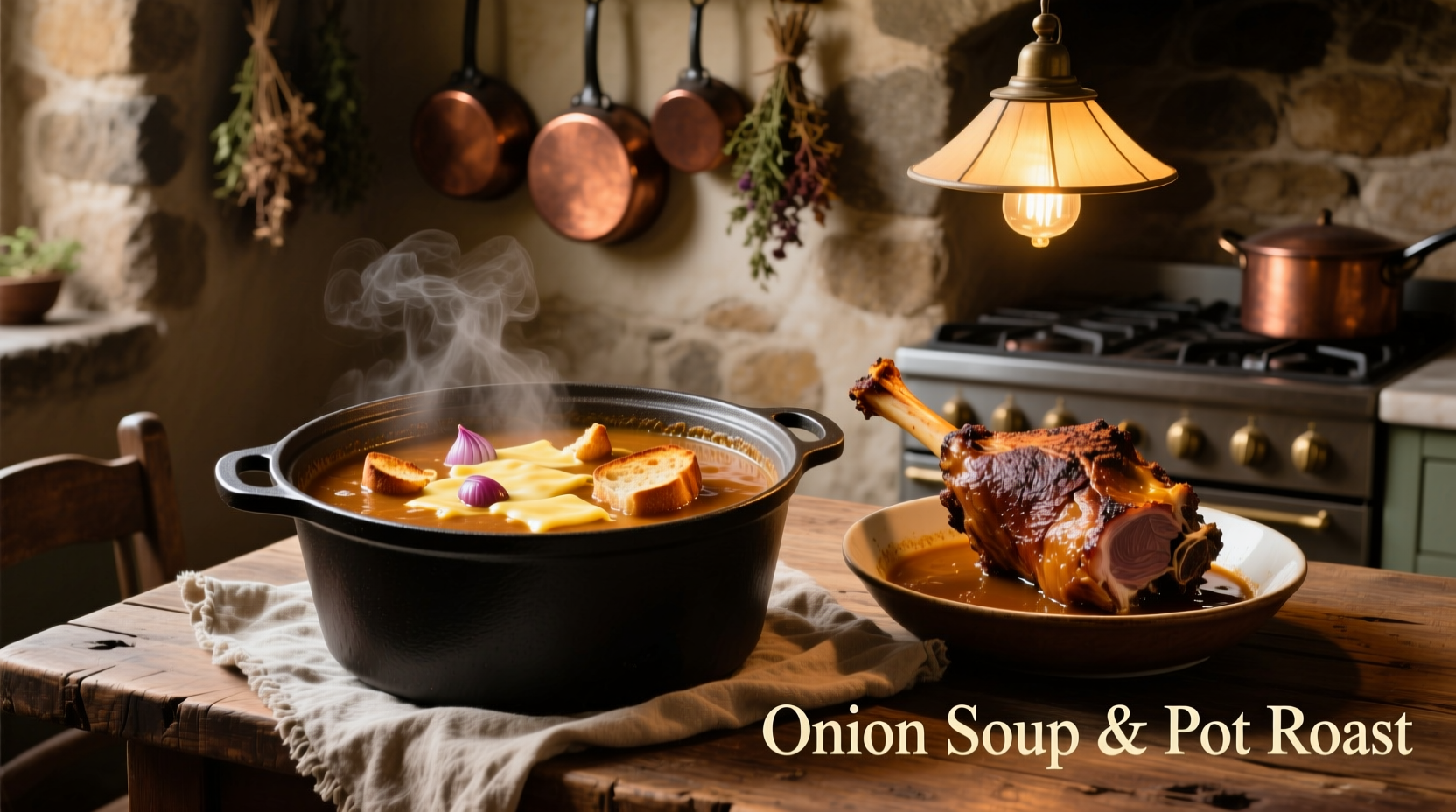The classic onion soup pot roast combines tender beef chuck roast with French onion soup mix for a rich, savory meal requiring minimal prep time and delivering maximum flavor. This one-pot wonder achieves perfect tenderness after 3-4 hours of slow cooking, with the onion soup mix creating an instant gravy packed with caramelized onion notes and subtle herbs.
There's a reason this recipe has been a staple in American kitchens since the 1950s—onion soup pot roast transforms an inexpensive cut of beef into something extraordinary with astonishing ease. As a French-trained chef specializing in European culinary traditions, I've tested this dish extensively to perfect the balance between convenience and authentic flavor development.
Why This Recipe Works Every Time
The magic happens through three key elements working in harmony: the natural sugars in onions caramelize during cooking, the gelatin in chuck roast breaks down into tender meat, and the dry soup mix creates an instant flavor foundation that would otherwise require hours of preparation. Unlike many "dump" recipes that sacrifice depth for convenience, this method preserves complexity while minimizing active cooking time.
Essential Ingredients Breakdown
While the recipe appears simple, understanding your ingredients makes all the difference:
| Onion Soup Mix Type | Best For | Flavor Profile | Recommended Brands |
|---|---|---|---|
| Dry Packet Mix | Traditional preparation | Salty, concentrated onion flavor | Lipton Recipe Secrets |
| Homemade Version | Enhanced depth | Fresh onion complexity | N/A (make your own) |
| Low-Sodium Commercial | Health-conscious cooking | Milder, requires seasoning adjustment | Swanson Unsalted |
According to the USDA Food Safety and Inspection Service, chuck roast reaches optimal tenderness when cooked to an internal temperature of 190-205°F (88-96°C), allowing collagen to fully convert to gelatin.
Step-by-Step Cooking Process
Preparation (15 minutes)
Start with a 3-4 pound boneless chuck roast—this marbled cut contains the perfect fat content for slow cooking. Pat the meat completely dry with paper towels, a crucial step many skip that prevents steaming instead of searing. Season generously with black pepper (the soup mix provides ample salt).
Searing for Flavor Foundation (10 minutes)
Heat 2 tablespoons of olive oil in a heavy Dutch oven over medium-high heat until shimmering. Sear the roast on all sides until deeply browned—this Maillard reaction creates complex flavor compounds that will permeate the entire dish. Don't rush this step; proper searing makes the difference between good and exceptional pot roast.
Slow Cooking Transformation (3-4 hours)
After searing, add one packet of French onion soup mix and 1½ cups of beef broth to the pot. The National Institute of Food and Agriculture confirms that slow cooking at 300°F breaks down tough connective tissues while preserving moisture. Cover tightly and transfer to a 300°F oven, or use a slow cooker on low setting.

Finishing Touches (20 minutes)
Once the roast reaches fork-tender consistency, remove it from the pot and tent with foil. Skim excess fat from the cooking liquid, then bring to a simmer and whisk in 2 tablespoons of cornstarch slurry to thicken the gravy. Return the roast to the pot for 15 minutes to reabsorb flavors before slicing against the grain.
Avoid These Common Mistakes
- Skipping the sear—this sacrifices the deep flavor foundation
- Overcrowding the pot—prevents proper browning
- Using lean cuts—chuck roast's marbling is essential for tenderness
- Adding vegetables too early—they'll turn to mush (add carrots and potatoes in the last 90 minutes)
Variations Worth Trying
Once you've mastered the classic version, experiment with these chef-approved adaptations:
- Red Wine Enhancement: Replace ½ cup of broth with dry red wine for added complexity
- Herb Infusion: Add fresh thyme and rosemary sprigs during cooking
- Garlic Boost: Include 6-8 whole roasted garlic cloves for subtle sweetness
- Mustard Twist: Stir in 1 tablespoon Dijon mustard with the cornstarch slurry
Serving and Storage Tips
Slice against the grain into ¼-inch thick pieces for maximum tenderness. Pair with roasted root vegetables or buttered egg noodles to soak up the rich gravy. Leftovers maintain quality for up to four days when stored in an airtight container with gravy—this dish often tastes even better the next day as flavors continue to meld.
Frequently Asked Questions
Can I make onion soup pot roast without the packet mix?
Yes, create a homemade version with ½ cup dried minced onions, 1 teaspoon beef bouillon powder, ½ teaspoon garlic powder, ½ teaspoon onion powder, and ¼ teaspoon black pepper. The flavor will be fresher but less concentrated than commercial mixes.
Why is my pot roast tough despite long cooking time?
Toughness usually indicates insufficient cooking time or temperature. Chuck roast requires 3-4 hours at 300°F to fully break down collagen. Check internal temperature—it should reach 190-205°F for proper tenderness. Using a leaner cut like round roast can also cause toughness.
Can I use French onion soup instead of the dry mix?
Yes, but reduce added liquid by 1 cup since prepared soup contains more moisture. Use one 10-ounce can of condensed French onion soup plus ½ cup broth instead of the dry mix and 1½ cups broth. The flavor will be slightly different but equally delicious.
How do I prevent the gravy from being too salty?
Use low-sodium beef broth and consider a low-sodium soup mix variant. If gravy is too salty after cooking, add a peeled raw potato to absorb excess salt, or dilute with additional unsalted broth. Always taste before adding extra salt since the soup mix contains significant sodium.
What's the best cut of beef for onion soup pot roast?
Chuck roast is ideal due to its marbling and connective tissue that breaks down during slow cooking. Brisket or bottom round can work as alternatives but may require longer cooking times. Avoid lean cuts like sirloin which will become dry and tough.











 浙公网安备
33010002000092号
浙公网安备
33010002000092号 浙B2-20120091-4
浙B2-20120091-4